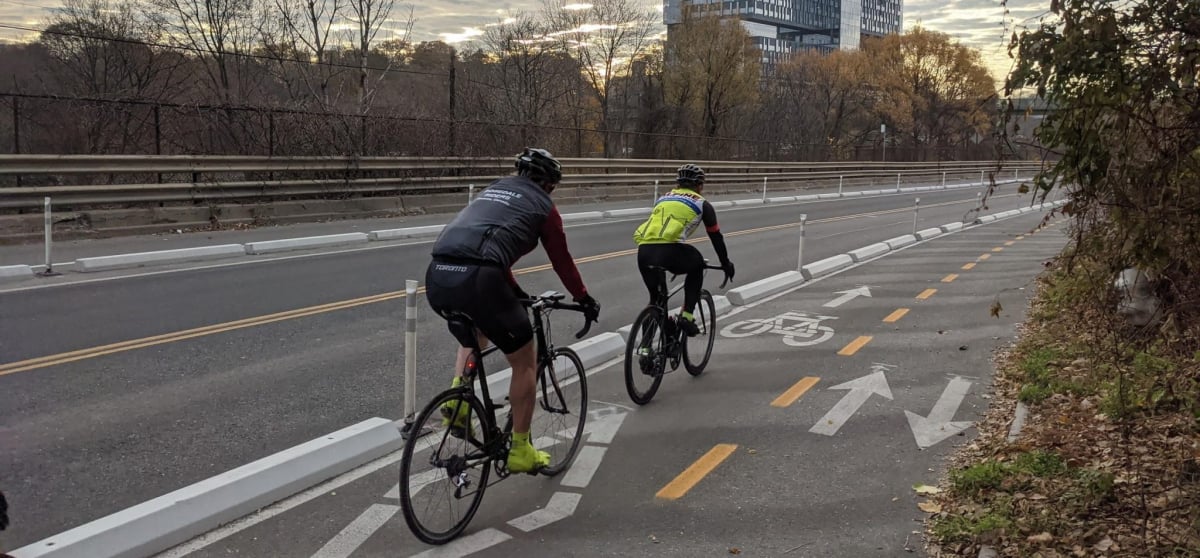Support strong Canadian climate journalism for 2025
Ian Borsuk has spent years advocating for safer, more sustainable transit options in Hamilton, but now he fears the Ford government’s proposed legislation will undo this progress.
The new rules would require municipalities to get provincial approval before installing bike lanes that reduce vehicle lanes — like the local Keddy Access Trail.
That bike lane is one of the most significant in Hamilton, connecting the city’s “upper” and “lower” regions. It was created in memory of Jay Keddy, a cyclist killed on the adjoining roadway.
The bike path required removal of a vehicle lane, and has significantly improved safety for cyclists and encouraged active transportation, Borsuk said. Under the Ford government’s proposed legislation, this project might never have been approved.
“It's not unique to Hamilton, Borsuk said. “All over Ontario, bike lanes have been installed because people lost their lives on unsafe roads.”
For Borsuk, cycling is more than just a way to get around the city — it’s a solution to the pressing issues of pollution, traffic congestion and climate change, all at once.
As executive director of Environment Hamilton, Borsuk views bicycles as an affordable, emission-free mode of transportation that keeps his city cleaner and healthier. “We should be encouraging people to adopt alternative modes of transportation that protect both our health and the environment,” Borsuk said. But infrastructure, like bike lanes, is essential for making these alternatives viable.
The city of Hamilton has an ambitious strategy to enhance cycling infrastructure. With over 560 kilometres of bike lanes, paths and other facilities already in place, the city is on track to achieve 75 per cent completion of its Cycling Master Plan with a $60-million investment targeting an additional 119 kilometres of new bike lanes by 2028.
More than half of the proposed bike lanes will be segregated from car traffic, prioritizing safety for cyclists.
Ford has defended his legislation as necessary to prevent gridlock. On Thursday, Ford even suggested that existing bike lanes might need to be removed to make room for more car lanes.
“By bringing sanity back to bike lane decisions, it isn’t enough to just keep an eye on future bike lanes,” Ford said. “We need to, and will, remove and replace existing bike lanes on primary roads that are bringing traffic in our cities to an absolute standstill.”
But since the announcement, pressure is mounting on the Ford government from advocates, mayors and other residents to reverse his decision. Borsuk’s organization is fighting back along with several environmental organizations across the province, including in Ottawa, Toronto, and Windsor.
They have urged local MPPs to oppose what they call provincial government overreach, and encouraged collaboration with municipalities instead.
A joint letter from the groups to the province says all municipalities are struggling to address road safety and congestion, along with their negative impacts on local economies, public health, and the environment. They argue that limiting municipalities' options and requiring provincial approval for local decisions will exacerbate these issues, create more time-consuming government red tape, and ultimately increase traffic fatalities.
“Bike lanes allow more people to travel in less road space, in addition to improving safety for all road users,” the letter reads. “Municipalities in Ontario need the power to implement the Transportation Master Plans they have developed for their context.”
Cycling advocates argue that there is growing demand for cycling as a viable transportation option. For instance, the Cannon Street cycle track in Hamilton, a major east-west corridor through downtown, was used by more than 80,000 cyclists between July and December last year.
Borsuk notes that in many cases, people are reluctant to use transportation options that have been proven to be dangerous.
By including infrastructure like bike lanes, municipalities are responding to both demand and the need for fewer drivers, Borsuk said.
“Doug Ford talks about keeping traffic moving, but the reality is that we’re never going to solve congestion if we don’t give people viable alternatives to driving,” he said.
Borsuk argues that it’s not the bike lanes causing congestion in Toronto and other big cities; rather, it’s the influx of drivers from areas without viable public transit options. He expresses concern that the provincial government is denying long-distance commuters safe, low-emission alternatives to vehicles, taking away options from local commuters instead.
“Instead of making it easier to take a GO train or cycle, the overwhelming focus is on preserving automobility for private vehicles,” he said.
That focus on driving ever-larger personal vehicles — on ever-growing roads — at the expense of other forms of transportation has been shown to worsen social inequities and environmental degradation.
From Toronto to Kitchener, mayors across the province are also opposed to the legislation, arguing that the province's plans to restrict bike lanes “step directly into municipal jurisdiction.”
In a statement, the Association of Municipalities of Ontario (AMO) stated that bike lanes are crucial for urban transportation planning and road safety, and requiring provincial approval would be a significant overreach.
AMO said municipalities rely on local knowledge and community input to develop transportation plans that balance traffic flow with priorities like active transportation and environmental protection.
“AMO is not aware of any consultation with municipalities regarding bicycle lanes or of the evidence the province considered in its decision,” reads the statement. “It is unclear how the Ministry of Transportation will be in a better position than municipalities to make decisions about local transportation matters.”






Comments
Doug Ford is such an embarrassment. We must resist using every possible means.
This is without a doubt, overreach by the Doug "The Thug" Ford government. Groups and municipalities definitely need fight this overreach to the highest courts if need be. Doug needs to stop meddling in municipal matters and focus more on the current housing and cost issues, much of which has been caused by his own policies.
Doug Ford, maybe it’s time for a state visit to the Netherlands, Belgium, and Paris…
Doug Ford is the poster boy for "Don't bother me with the facts, my mind is made up" (Subtext, Bike lanes do not generate revenue to the party coffers) And anyway, we can't compare Toronto or Ontario to the ancient cities in Europe!...more's the pity
WHY ??
Bike lanes within sane reasons is all right but what next ?? BIKE LANES ON 400, 401 ,etc .!